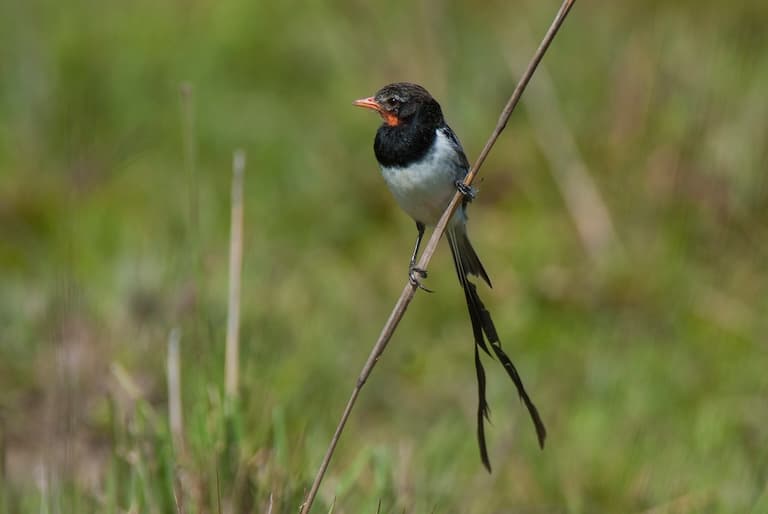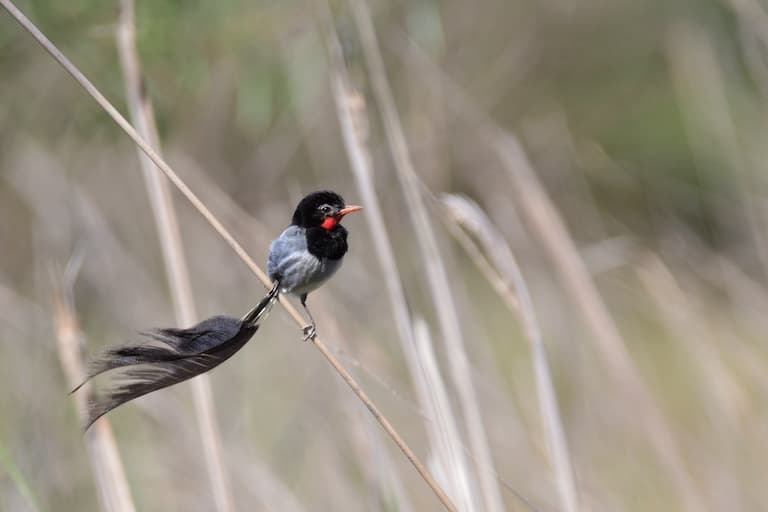Strange-tailed Tyrant Profile
Not all tyrants are as orange and bloated as we’ve become familiar with in recent years. In the Americas, there’s a whole family of adorable, fluffy little tyrants with tufts and sometimes long, impressive tails.
They get the name from the aggressiveness of a single species, described in the 1700s as particularly aggressive towards other birds approaching its nest.
Even overlooking the injustice of labelling self-defence as tyrannical, the whole family got unfairly slapped with the reputation and now all 400+ species are trying their best to look as innocent as possible.
And succeeding. The Strange-tailed tyrant is one such example, that’s so humble that it’s starting to go extinct.

Strange-tailed Tyrant Facts Overview
| Habitat: | Wet grasslands savannas, and marshes |
| Location: | From Paraguay to the North-eastern regions of Argentina |
| Lifespan: | Unknown |
| Size: | Around 20 cm (8 in), or 30 cm (12 in) with breeding plumage |
| Weight: | 4 to 5 g (0.14 to 0.18 oz) |
| Colour: | Males are black and white with a red cheek, yellow bill and long tail. Females are grey and white with slimmer tails. |
| Diet: | Invertebrates |
| Predators: | Mostly foxes |
| Top Speed: | Not listed |
| No. of Species: | 1 |
| Conservation Status: | Vulnerable |
Unfortunately, T-Rex has no direct descendants around today, but as we all know, birds are Therapod dinosaurs, so do share a clade with them. And Tyrant flycatchers do terrorise small invertebrates, much like Rexy did with the Ornithischians.
But other than this, and the name, of course, there’s a world of difference. T-rex likely did have feathers, but not as impressive as these little guys, whose beautiful and strange tails are used to great effect in mating displays.
They’re also known for their cunning, following larger animals to food sources and are highly adapted to grassy wetland ecosystems. Sadly, these are some of the most threatened spaces on land, and consequently, this species is now in trouble.
Interesting Strange-tailed Tyrant Facts
1. They’re New-World Flycatchers
The tyrant flycatchers are a remarkably diverse family of passerine birds found across North and South America.
With over 400 species, they are possibly the largest avian family in the world, yet they are not particularly related to the Old-World flycatchers like the European Robin, they just kind of look similar.
The strange-tailed tyrant is one of two species in the genus, and quite a large flycatcher, endemic to Argentina and southern Paraguay, which is a very small range and suggests the high degree of specialisation that we’ll touch on later. 1
2. They have strange tails
If you were to take the wing feathers of a blackbird and stick them up the cloaca of a sparrow, you might have something similar to the silhouette of the strange-tailed tyrant. You shouldn’t do this, of course – sparrows don’t like anything up there at all, and the blackbird wouldn’t appreciate it much either.
This tail is not strange just because it’s long, but because it really does look stuck-on, with highly modified feathers that are long and twisty, reduced to just a shaft at the base.
Females have some amount of tail like this but the males have impressive mating plumage which works with their intricate mating dances to make the ladies go wild. 2 3

3. They’re smart
This species has been seen following other animals to food sources.
The South American army ant species Labidus praedator is one of the most abundant swarm-raiding ants on the continent, and the strange-tailed tyrant uses their foraging paths to find insects to eat.
Yellow armadillos, another insect-eater, are also a common landmark that the flycatchers follow to find food.
4. They’re grassland specialists
This species is well-adjusted to grasslands, and their ability to recognise and act upon the behaviour of other species in their community is a sign of this.
But they also have a preferred species of grass with which to make their nests and even seem to prefer a certain span of time between nest building and natural grass fires.
All of these quirks evolved over a long time to give the species a tailored affinity for this specific habitat, and while specialists do better than most in their ecosystems, they are the most vulnerable to any changes that occur in it. 4

5. They’re threatened
Agricultural conversion of grasslands is the major threat to strange-tailed flycatchers. Their small range and specialist requirements mean that routine burning of grasses in their range has resulted in a decimated population and they’re now considered threatened and in decline.
Soybean expansion and overgrazing are two more factors that contribute to their decline, and conservationists are trying to push for less frequent burnings and more controlled use of the space in order to protect them.
6. They have a hard life
Nest survival rates are low already, without the added threats of habitat conversion, and adults of this species have come through a lot to reach maturity.
At a base survival rate of 0.23, nest success is low, and each year it gets lower. Most seasons take two or three nesting attempts by the female to get started. Figuring out the factors that contribute to successful breeding may be critical to the conservation of the strange-tailed tyrant.

7. Arthropods may be a key to their success
The beginning of the breeding season correlates with the peak of arthropod availability, and as this abundance decreases, breeding seasons become shorter.
Orthopterans appear to be the most important, and these are the grasshoppers and crickets, but their abundance alone doesn’t solely explain their behaviour, as the preference for upland habitats seems to be driven by other factors, too, and figuring out what these are should help conservationists plan for their protection better.
Strange-tailed Tyrant Fact-File Summary
Scientific Classification
| Kingdom: | Animalia |
| Phylum: | Chordata |
| Class: | Aves |
| Order: | Passeriformes |
| Family: | Tyrannidae |
| Genus: | Alectrurus |
| Species: | risora |
Fact Sources & References
- “Tyrant flycatchers”, IOC World Bird List.
- “Strange-tailed Tyrant Alectrurus risora”, eBird.
- “Strange-tailed Tyrant”, oisseaux birds.
- ALEJANDRO G. DI GIACOMO (2011), “Effects of grassland burning on reproductive success of globally threatened Strange-tailed Tyrants Alectrurus risora”, Cambridge University Press.
